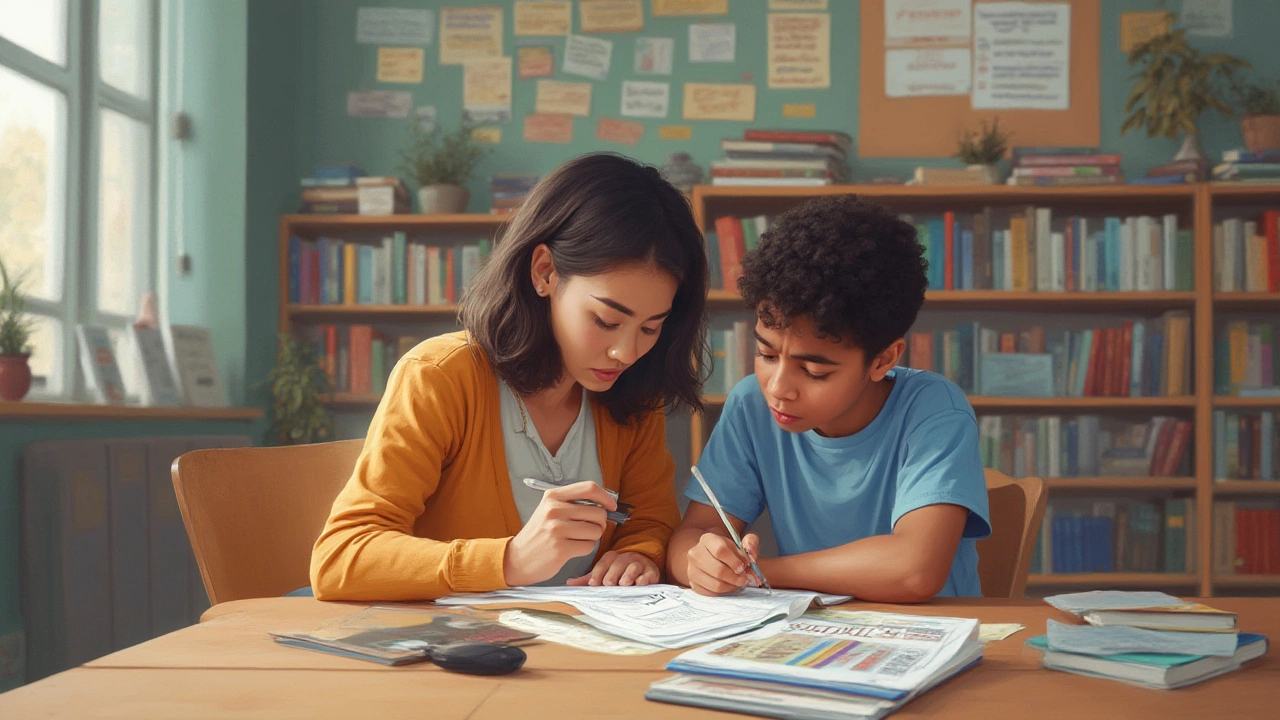Forget the picture-perfect images of tutoring you see in ads: students leaning forward in their seats, pencils poised, everyone smiling. The real thing—especially the first time—can feel more like wrangling a grumpy housecat than orchestrating a beautiful symphony. Breaking through the awkwardness, figuring out where to start, and making sure you aren't just reading from a script (or being ignored) takes more than just knowing your stuff. If you've never tutored before, buckle up. It might surprise you, but what matters most isn’t having all the answers. It's about connecting, listening, and learning together with your student. Oddly enough, working with humans can be messier and way more satisfying than nailing algebra alone. So how do you get that first tutoring session right?
Understanding Your Student and Setting the Stage
If your first tutoring gig has you sweating bullets, that's absolutely normal. Most people go in thinking they’ll just explain things better than the classroom teacher and call it a day. Reality check: every student is different. Some are like my cat Luna—skittish at first, and hard to read. Others come in chatty, but actually dread looking clueless. So start your first session as a human, not as a walking textbook.
Get to know your student as a person. Ask questions that aren’t just about grades or homework. What do they like outside of school? What was their favorite class, and why? This isn’t small talk—it’s your secret weapon. The more you know, the better you can frame explanations and examples that stick. Don’t be afraid to share a bit about yourself, too. Research into effective tutoring has shown that students are more likely to engage if they see their tutor as approachable and relatable. According to a study published in the "Journal of Educational Psychology" in 2023, students who felt a personal connection with their tutor reported 30% higher satisfaction and demonstrated improved subject understanding over the course of just four weeks.
Once you’ve broken the ice, set the agenda together. Ask what’s making them frustrated. Sometimes, the thing they need help with is not what you expected. Create a simple action plan for your session. Write it down, or use a shared digital doc. This way, your student always knows what to expect, and you have a roadmap to keep you on track. It might sound basic, but clarity here builds trust, and studies from the National Tutoring Association suggest that students who know the session plan in advance show an average of 18% more improvement in topic retention.
Environment plays a huge role, too. Find a quiet space—whether you’re meeting in person or online—free of distractions. Turn off notifications. If your student is easily distracted, try the Pomodoro technique: 25 minutes of focused work, followed by a 5-minute break. Bring snacks or water if that helps relax things. A simple change, like allowing a five-minute stretch for someone fidgety, can make your session hundred times more productive. Just like Luna gets a treat for not knocking my mugs off the table, students need positive cues for staying focused.

Practical Tips, Mistakes to Avoid, and Making Learning Stick
If you think tutoring is just about re-explaining what the teacher said, you’re missing the best part. Effective tutoring is interactive. Think about how you learned to ride a bike—did someone just describe pedaling to you? Nope. Learning sticks when you do, not just listen.
Use plenty of open-ended questions. Instead of "Do you get it?", try "Can you walk me through your thinking on this problem?" This reveals real gaps, helps students practice verbalizing ideas, and prevents that fake nodding syndrome we’ve all seen. When they’re stuck, resist the urge to jump in too fast. Wait. Give them room to wrestle with the problem. Studies on the “wait time” effect have shown that students given just 3 more seconds to answer after a question perform 20% better on tests later.
When you do jump in, model your thinking out loud, including your mistakes. If you fumble a calculation, don’t sweep it under the rug. Instead, talk through the correction. This normalizes mistakes and makes it clear that smart people get it wrong, too. This growth mindset approach, made famous by Stanford professor Carol Dweck, has been linked in real classrooms to better grades and more persistent students.
Make things visual whenever possible. Even if you’re tutoring something like history, draw timelines, mind maps, or sketch out cause-and-effect arrows on scrap paper or a whiteboard. In math and science, a rough sketch is worth a thousand words. According to the Education Endowment Foundation, visual aids boost understanding by up to 25% compared to straight-up lecturing. Here’s a quick breakdown of the impact of tutoring approaches based on UK research in 2024:
| Technique | Retention Improvement |
|---|---|
| Interactive Dialogue | +30% |
| Visual Aids | +25% |
| Practice Problems | +33% |
| Passive Lecture | -5% |
Notice the drop with passive lecture. That’s your warning sign. Avoid just talking at your student. Instead:
- Use their homework as a jumping-off point—don’t do it for them, but guide their thinking.
- Have them explain concepts to you, as if you were the one learning.
- Pick out every little win—praise the approach, not just the right answer. “I like how you started with the diagram here.”
Be vigilant for classic rookie errors. Don’t overload a first session with information. The human brain, especially a stressed one, can only take so much. Prioritize a couple of clear skills or topics and circle back to them at the end to check understanding.
Adapt on the fly. If you notice them zoning out, change the activity or take a short break to chat about something unrelated. Trying to force through when it's just not working never goes well. Good tutors read the room; great tutors change the room.
Also, every student has a different “best learning style”. A quick tip: ask your student how they like to learn, but don’t build everything around the answer. Instead, mix it up. If you rely only on talking, try drawing. If they seem to tune out with writing, switch to games or flashcards. Research keeps showing that having a varied approach works best. Luna, for instance, only listens if I shake the treat bag as I’m calling her. Different approach, guaranteed attention.
Don’t forget to keep track of progress. That doesn’t mean endless tests, but maybe a recap at the end about what they feel went well or still needs work. It’s not just for you—it helps them build their sense of progress and confidence, which is more valuable than any worksheet pile.

Taking It Forward: Building Confidence and Growing as a Tutor
First-time tutoring is like jumping into cold water—the first few minutes are uncomfortable, but you adjust fast. What really matters after that debut? Keeping momentum. The secret to becoming a solid tutor is viewing every student as your best "teacher." Be curious—ask for honest feedback about what worked and what didn’t. Show you’re learning, too. This makes your student more likely to be open about their struggles next time.
Reflect after each session, just like athletes watching game tape. Jot down what clicked, what flopped, and any clues about your student’s learning style. If something bombed, don’t panic—it’s part of the game. Even veteran tutors strike out now and then. Keep a simple log (yes, even a note on your phone works) so you track patterns. After a few weeks, you’ll spot what approaches get the best “lightbulb moments.”
Keep your resources handy. Have links, practice problems, videos, or interactive apps tailored to your subject ready to go. One underrated tip: build a “toolkit” or digital folder that grows with you. Each time you find something a student loves (a math puzzle, a goofy grammar video), save it. The best tutors are magpies for useful stuff.
Tutoring isn’t just for the academic whiz either. You don’t need to cover everything in detail to be an awesome coach. The real goal is to help your student become an independent learner—someone who asks better questions, sets goals, and isn’t afraid of mistakes. The boost in student confidence that comes from even one positive experience can ripple out into new subjects, higher test scores, and better self-esteem. According to the Education Policy Institute, effective private tutoring can cut the achievement gap by 50% for students from disadvantaged backgrounds in just one academic year. That’s real impact, and it starts with each session.
Finally, don’t be afraid of your own personality in your sessions. If you’re goofy, don’t try to act super formal. If you’re quiet, use that to really listen and support. Your quirks—like my habit of talking too much about my cat Luna—can help you bond. Let your student see you as a person, not just a "teacher."
Stepping into tutoring for the first time can be stressful, awkward, and even chaotic—but it also opens up moments of genuine connection and growth, for both tutor and student. Learn as you go, let go of the need to be perfect, and you’ll never stop getting better at it.






